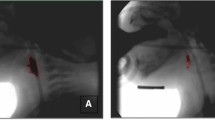Abstract
A number of tests for evaluating dysphagia without using videofluoroscopic examination of swallowing (VF) or videoendoscopic evaluation of swallowing (VE) have been developed. The simple swallowing provocation test (SSPT) is unique because it is performed while in a supine position and does not require the patient’s cooperation. However, whether the SSPT detects aspiration or penetration correctly is unclear because its validity determined by VF or VE has not been evaluated. Therefore, we determined the sensitivity, specificity, and predictive accuracy of SSPT followed by VF in 45 patients. The sensitivities of the first-step and the second-step SSPT for the detection of aspiration, silent aspiration, or penetration were 72–75% and 13–17%, respectively; the specificities of the first-step and the second-step SSPT were 38–44% and 80–89%, respectively; and the predictive accuracies of the first-step and the second-step SSPT were 58–67% and 31–49%, respectively. These data suggest that SSPT has limited applicability as a screening tool for aspiration, silent aspiration, or penetration because of its low sensitivity. This test may be useful for patients who cannot undergo other tests due to cognitive and/or linguistic dysfunction.
Similar content being viewed by others
References
Colodny N. Interjudge and intrajudge reliabilities in fiberoptic endoscopic evaluation of swallowing (FEES®) using the penetration-aspiration scale: a replication study. Dysphagia. 2002;17:308–15. doi:10.1007/s00455-002-0073-4.
DePippo KL, Holas MA, Reding MJ. Validation of the 3-oz water swallow test for aspiration following stroke. Arch Neurol. 1992;49:1259–61.
Tohara H, Saitoh E, Mays KA, Kuhlemeier K, Palmer JB. Three tests for predicting aspiration without videofluorography. Dysphagia. 2003;18:126–34. doi:10.1007/s00455-002-0095-y.
Teramoto S, Fukuchi Y. Detection of aspiration and swallowing disorder in older stroke patients: simple swallowing provocation test versus water swallowing test. Arch Phys Med Rehabil. 2000;81:1517–9. doi:10.1053/apmr.2000.9171.
Nishiwaki K, Tsuji T, Liu M, Hase K, Tanaka N, Fujiwara T. Identification of a simple screening tool for dysphagia in patients with stroke using factor analysis of multiple dysphagia variables. J Rehabil Med. 2005;37:247–51. doi:10.1080/16501970510026999.
Lim SHB, Lieu PK, Phua SY, Seshadri R, Venketasubramanian N, Lee SH, et al. Accuracy of bedside clinical methods compared with fiberoptic endoscopic examination of swallowing (FEES) in determining the risk of aspiration in acute stroke patients. Dysphagia. 2001;16:1–6. doi:10.1007/s004550000038.
Oguchi K, Saitoh E, Baba M, Kusudo S, Tanaka T, Onogi K. The repetitive saliva swallowing test (RSST) as a screening test of functional dysphagia (2). Validity of RSST. Jpn J Rehabil Med. 2000;37:383–8.
Trapl M, Enderle P, Nowotny M, Teuschl Y, Matz K, Dachenhausen A, et al. Dysphagia bedside screening for acute-stroke patients. The Gugging Swallowing Screen. Stroke. 2007;38:2948–52. doi:10.1161/STROKEAHA.107.483933.
Teramoto S, Matsuse T, Fukuchi Y, Ouchi Y. Simple two-step swallowing provocation test for elderly patients with aspiration pneumonia. Lancet. 1999;353:1243. doi:10.1016/S0140-6736(98)05844-9.
Teramoto S, Matsuse T, Matsui H, Ohga E, Saitoh E, Ishii T, et al. The simple swallowing provocation test as a means of screening for swallowing disorders: a comparison with the water swallowing test. J Jpn Res Soc. 1999;37:466–70.
Teramoto S, Yamamoto H, Yamaguchi Y, Ouchi Y, Matsuse T. A novel diagnostic test for the risk of aspiration pneumonia in the elderly. Chest. 2004;125:801–2. doi:10.1378/chest.125.2.801.
Scott A, Perry A. Two-step swallowing provocation test for elderly patients. Lancet. 1999;353:2246. doi:10.1016/S0140-6736(05)76298-X.
Pouderoux P, Logemann JA, Kahrilas PJ. Pharyngeal swallowing elicited by fluid infusion: role of volition and vallecular containment. Am J Physiol. 1996;270:G347–54.
Teramoto S, Matsuse T, Ouchi Y. Two-step swallowing provocation test for elderly patients. Authors’ reply. Lancet. 1999;353:2246. doi:10.1016/S0140-6736(05)76299-1.
Teramoto S, Matsuse T, Fukuchi Y. Decision-making for safe feeding after stroke. Lancet. 2000;356:1352. doi:10.1016/S0140-6736(05)74258-6.
Langmore SE, Terpenning MS, Schork A, Chen Y, Murray JT, Lopatin D, et al. Predictors of aspiration pneumonia: how important is dysphagia? Dysphagia. 1998;13:69–81. doi:10.1007/PL00009559.
Author information
Authors and Affiliations
Corresponding author
Rights and permissions
About this article
Cite this article
Kagaya, H., Okada, S., Saitoh, E. et al. Simple Swallowing Provocation Test Has Limited Applicability as a Screening Tool for Detecting Aspiration, Silent Aspiration, or Penetration. Dysphagia 25, 6–10 (2010). https://doi.org/10.1007/s00455-009-9222-3
Received:
Accepted:
Published:
Issue Date:
DOI: https://doi.org/10.1007/s00455-009-9222-3




